The Cuillin Ridge: It still scares the bejeezus out of me!
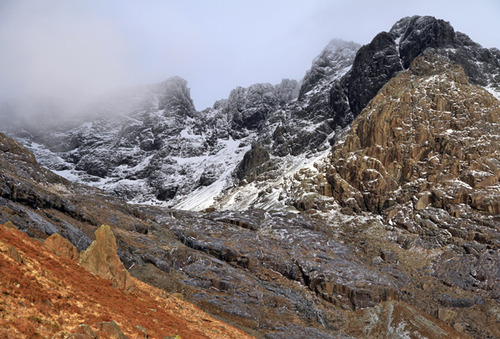
I remember so vividly the first time I went walking in Scotland after moving up here. I chose the Brack, near the Rest and be Thankful. I’d chosen it because it was close to a road, was of comparable height and a walk of comparable distance to the kinds of things I was already familiar with in Wales:

I wanted a nice introduction that didn’t feel too far flung because, though desperate to do so, the prospect of heading straight up a 4000ft peak by myself was a little daunting.
Not scary per se. But it did feel like a step up. Hillwalking in Scotland, in general, felt like a step up from Wales.
I decided to build up gradually but swiftly to greater things rather than jumping in feet first. Slowly as your experience builds you learn to feel at ease in your surroundings and your confidence increases.

Despite increasing confidence in that first year, two places maintained an intimidating presence in my head. The Cairngorms and the Cuillin.
The former were so vast, featureless, inhospitable and wild that I think I was rightly scared of them for a while:
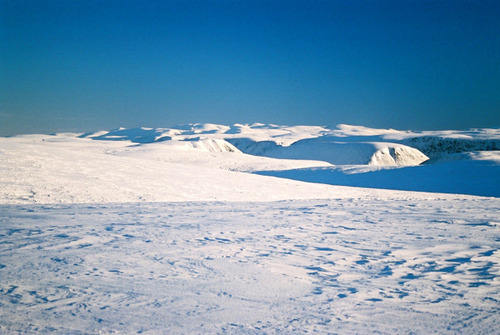
It took quite a few visits into the glens and onto the plateau in all kinds of weather before I started to feel it was an environment I could navigate through with a degree of confidence.

Slowly their outright intimidation receded, replaced with a healthy respect that has never left me. The Cuillin, however, still maintained that intimidating presence.
That’s partly because I’d never actually set foot on them in all the years I’d been walking in Scotland, and partly because of the Cult of the Cuillin that I’d unwittingly allowed to set up shop in my head. A constant supply of facts, figures, photos and horror stories had established an air of danger and mystery around them, and was undoubtedly responsible for me keeping them at arm’s length.
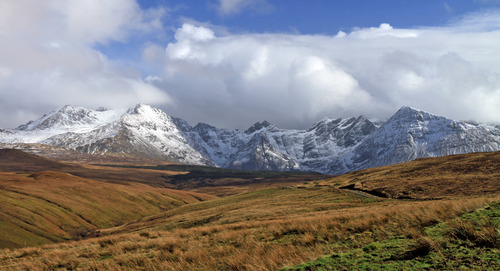
And with good reason, for the Black Cuillin are a wild and rugged range of mountains without equal in the British Isles. A landscape of rock, narrow ridges and fractured pinnacles combining to form the closest thing we have to a truly alpine climbing experience.
A strange and treacherous place where navigation is challenging even in good conditions, and where even a trusty compass cannot be relied upon because of the magnetic properties of the rock.
That last point more than any other unnerved me, I have to say, as it’s a phenomenon pretty much unique in Scotland. Their reputation as being somehow different to everywhere else was therefore well deserved. Perhaps the very fact they were off the mainland on an island of their own only seemed to reinforce that sense of difference.
I wasn’t a complete stranger to them, however. Like many outdoors enthusiasts I’d seen them from a great many vantage points over the years. I spent weeks on the Isle of Rum, staring out at the impossibly steep flanks of Skye’s hills as they rose straight out of the sea.

They always looked stupendous. Jagged, high, dark, often cloaked in gloom or mist:

If they revealed themselves then they’d be sharp and pointed, streaked with late season snow in Spring time that traced the maze of gullies and cracks across their flanks.
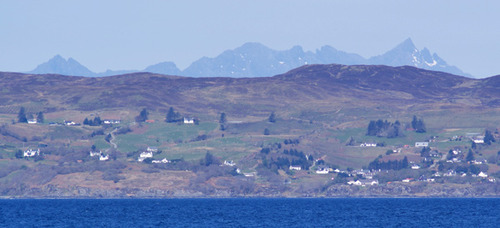
Writing this now, I’m not at all surprised I was apprehensive about venturing into them, not least because hillwalking had been and generally always is a solitary venture for me. The Cuillin made me feel as though I should probably have company with me when I did them, and that didn’t sit well with me. From the outset they made me nervous on many levels.
But I knew I would indeed have to face them eventually because, yep, I was one of those blinkered bagging types. And if I wanted to get around all 284 munros (such as I think there were in 2003), I would eventually have to venture onto the Cuillin, either befriending some climbing folk or hiring a guide for the more challenging peaks, not least for the Inaccessible Pinnacle.
Long before I got the chance to meet them face to face, however, the bagging bug left me. My hillwalking was released from its 3000ft shackles and the Cuillin unexpectedly became an option rather than a necessity. They became a choice.
And the fact of the matter is I always chose other options. I fixated on other places like Assynt and Torridon, I immersed myself in the wilds of Sutherland, but that didn’t mean I was any less fascinated by the Cuillin. I was no less in awe and no less eager to gaze upon them. I just didn’t really have much of a desire to climb them.
Even back in the bagging days I’m not sure how keen I was. The idea of picking the easier munros off one by one never really appealed. It felt a bit piecemeal, tokenistic and unlikely to do justice to such a fine range of hills.
Instead I always imagined I’d do the ridge in one go, hiring a guide and benefitting from their considerable insight and instruction. But in all these years it never happened.
I never even went to Skye, save for a solitary weekend visit in 2005 when I didn’t really venture off Sleat save for nipping up and down Bla Bheinn:

Though it was clear when we set out, the cloud descended as we neared the summit and I never got to see the Cuillin ridge close up. The cottage had amazing views across to them though, so I spent the rest of those few days staring at them from afar rather than climbing them:

Then, two weeks ago, I found myself on Skye for the first time in nearly ten years. I’d deliberately rented a place near Staffin in Trotternish as I wanted to explore the Quiraing and the coast. After a week I’d intended to move on to Sutherland or Ardnamurchan.
But during that week, Skye unexpectedly got under my skin and I decided to stay on the island a second week, albeit in Carbost instead of Staffin.
Suddenly the Cuillin were going to be just a few miles away, for a whole week. I pored over the OS map and planned where I’d like to go.
The Red Hills were at the top of the list and, though I hadn’t gone with any intention of heading up onto the Cuillin ridge itself, I certainly wanted to get close and get into the heart of the Cuillin if weather allowed. Perhaps walking in to Loch Coruisk or Coir’ a Ghrunnda or some lower level lochans and coires. I wanted to look upon the ridge, see its jagged grandeur for myself but from a comfortable distance.
On the changeover day I drove from Staffin to Carbost on a gloriously sunny Saturday:

The first week had been one of incessant gales, hail, snow and drizzle, with scant appearance of the sun. This second week was looking much more promising. This was looking like hillwalking weather.
Arriving at my accommodation around lunchtime, it was such a stunning day that I just dumped all my stuff and headed straight up into Glen Brittle.
I’d heard that Coire Lagan was a nice short walk that would get me into the dark recesses of the Cuillin and give me a taster without actually getting stuck into scree slopes or scrambling. Neither of which I have a problem with anywhere else but, like I say, these hills had established quite a presence in my head. They were and indeed still are very much ‘mountains of the mind’.
Driving the few miles from Carbost I rounded a corner and suddenly there they were, stretched out like a huge monochromatic wall of rock on the horizon. I pulled over to stand and gawp. They looked absolutely stunning. Inviting, even. And of course they looked every bit as formidable as I’d led myself to believe.

The car park was at the beach, right at the end of Glen Brittle. It was a beautiful afternoon, the sea shimmering silver in the sunshine. A few folk strolled across the sands:
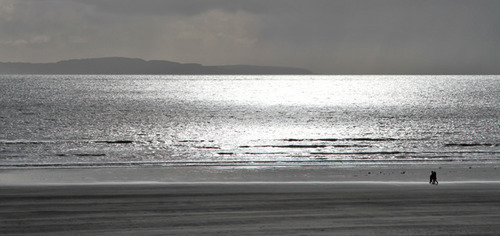
With the familiar bleakness to the setting it was hardly the Carribean but it still felt utterly incongruous sat next to the dark brooding towers of rock I was venturing into. Though the sun was out and the lower landscape was the reassuring rusty brown of vegetation outwith summer, beyond there was only rock. White where it was covered by snow, jet black where it was not:

Ascending on the excellent path the craggy jumble of notches on the ridge loomed larger as I got higher:
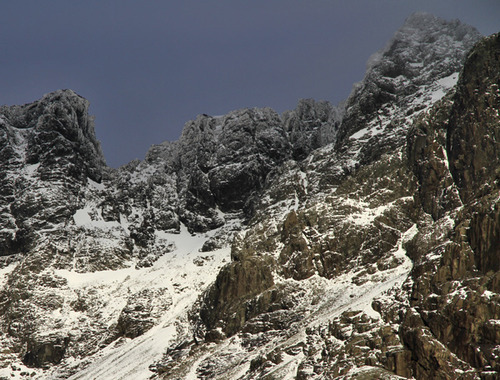
Buoyed by the warm sun and the thrill of visiting a place I’d long wanted to visit, I raced up to the lochan in a t-shirt despite the occasional light snow shower.
Before long I was stood at the lip of the coire on a sunny, snowy platform with views out to Canna and beyond. It was calm, it was warm, and there was nobody else around. No footprints in the snow. It was stunningly beautiful:
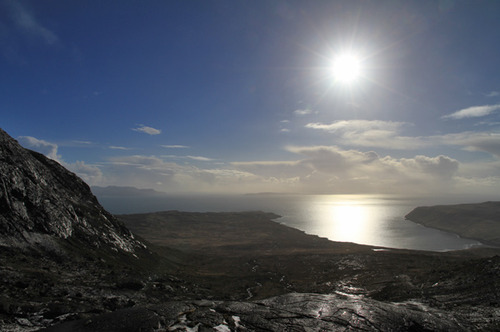
Beauty wasn’t something I’d necessarily expected to find up there, such was my expectation of finding only intimidation and grandeur. I shouldn’t have been surprised, of course, for these are coastal hills and they therefore have the winning mix of light, space and rapidly changing weather you’d expect to get.
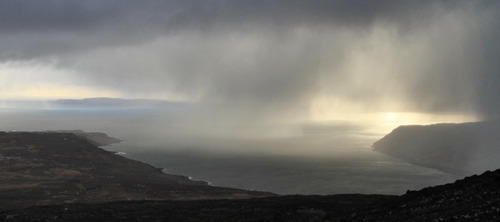
After a cool, wet, windy winter the sun felt amazing. In spite of the snow all around me this was the first time I’d felt warm on a hill since the autumn:
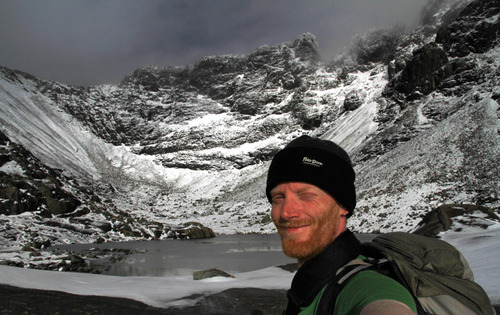
The urge to push upwards was worryingly tempting so I sat down on a rock and stared at the scree slopes on the other side of the lochan to scan for ways up. I wasn’t going to actually head up there right then, rather I was picturing myself heading up, working out which route I’d take.
It looked okay, though a bit of a slog. I decided there and then I’d try and get up onto the ridge that week if I had time left over, boosted in no uncertain terms by gloriously snowy views of the ridge from the nearby Red Hills the following day:

Even so, the coast was still more appealing so I spent the rest of that week exploring Waternish, Duirinish and other places, all the while keeping an eye on the weather in case a really good hill day should present itself.
Every day was glorious and so were the views of the Cuillin as I explored northwest Skye:

It had been windy though, and with those winds forecast to abate somewhat on Friday I marked that down as 'the day’. By now Scotland was in the grips of an easterly straight off the North Sea, so while much of the country languished in murk and drizzle, Skye was reliably sunny and I was confident that the tops would remain clear all week.
Heading up onto the Cuillin ridge on the last of my 14 days on Skye, with an already impressive checklist of places and wildlife encounters under my belt, seemed the perfect way to end.
I opted for a walk up Sgurr na Banachdich. By all accounts one of the easier munros on the ridge and therefore a perfect introduction. I didn’t mind if it was considered easy, I just wanted to get up onto the ridge, sit there and take it all in.
Starting off from the Glen Brittle youth hostel was quite stirring. For years I’d read about Glen Brittle and the exploits of people using it as a staging post for exploring the Cuillin, such that it had acquired the same almost mythical status as other well-known staging posts. Chamonix, Namche Bazaar, Concordia.
Obviously Glen Brittle isn’t on quite the same scale as those three in terms of the mountains it provides access to, but size is irrelevant. Quality of personal accounts and the sense of the unknown as climbers first explored the Cuillin have made Glen Brittle equally as inspiring and evocative of the spirit of adventure.
It felt quite strange to be there, unassuming as the glen actually looked. It could have been anywhere in Scotland, really.
A good path made for quick progress along the Allt a’ Choire Ghreadaidh, offering beautifully enticing views up to Sgurr a Ghreadaidh:
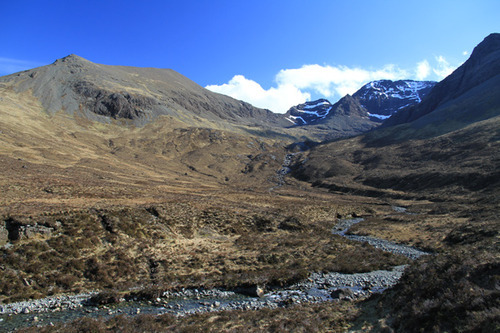
I took the ridge line up An Diallaid, which offered increasingly expansive views out over the scree-filled Coir’ an Eich to the Western Isles on the horizon:

There were no difficulties on the ascent. It was just relentlessly steep and increasingly rocky. As I got higher the Small Isles appeared from behind the long ridge of Sgurr nan Gobhar:
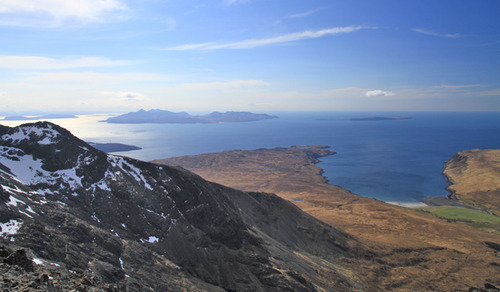
The rock underfoot was wonderfully coarse and therefore grippy. The volcanic gabbro the range is so famous for. But I did wonder what would be left of my hands if I scrambled along the whole ridge. It’s like rubbing and grabbing sandpaper all day. Perhaps not surprisingly my mind then considered the unhappy scenario of a tumbling fall on rock as coarse as this. Would there be anything left of me when I hit the bottom?
As I climbed still higher I got my first view of the Cuillin ridge snaking its way southeast:

Then, without warning, I ran out of rock. I was at the modest summit, rudely greeted by the jaw-dropping open space below me on the other side of the ridge:
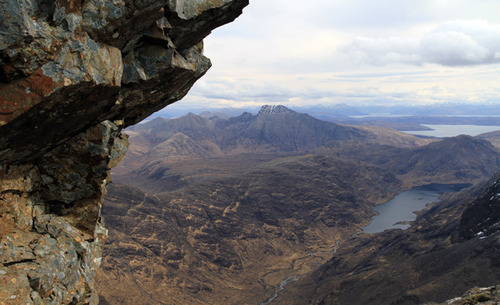
I was elated and stood gawping for a wee while before heading along the summit ridge to a handy seat. There was little or no wind, the hazy sun was warm, and there was nobody about. It was perfect.
I sat there with one leg either side of the narrowest part of the summit ridge, in absolute awe of the scene before me. I’d primed myself to be impressed and my heart was racing as I neared the ridge proper. But this was way beyond anything I was actually expecting. I was expecting drama, yes. Cragginess certainly. But nothing I’d read actually prepared me for the reality.
For ten minutes or so I just gazed in bewilderment at the gnarled, black ridge stretching away into the distance:
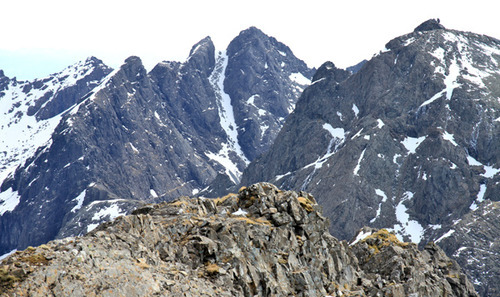
It rose and fell in impossibly steep slopes, leading to and from the most serrated and pointed summits I’ve ever seen in Scotland. To call these hills would do them an injustice. They looked more like the fractured ridges in the French Alps. True to stereotype these were the most alpine things I’d seen in this country. These were mountains!
Famous sights, hallowed in the annals of mountaineering were laid out in front of me and it felt genuinely moving and inspiring to finally set eyes upon these places for myself. Remote Loch Coruisk lay far below, tucked behind the farthest reaches of the ridge:
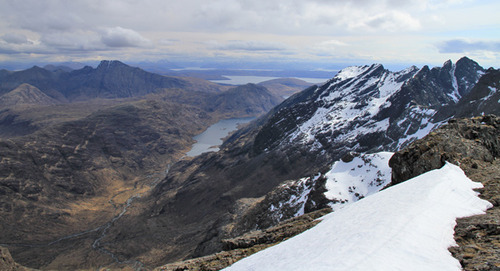
To my right, looking deceptively close and therefore deceptively small, the very top of the Inaccessible Pinnacle could be seen poking up above the ridge line:
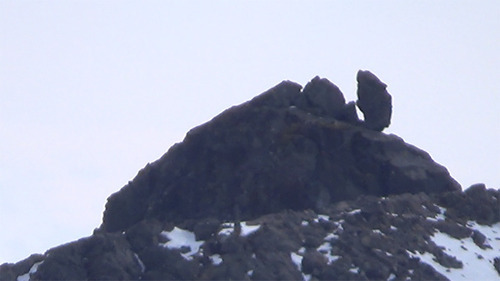
The odd flea-shaped rock on the summit looked impossible, barely attached. This, I think, is where the rock was struck by lightning a few years ago and resulted in the weirdly balanced remains you now see. Viewing it in isolation with nobody sat on top of it gives you no sense of scale. Rest assured even in a close-up like this, folk would look very small when they’re sat on top of it.
Indeed when I posted a photo of me sat at the summit of Sgurr na Banachdich (see below), quite a few people thought the big black lump on the hill to the right was a summit cairn and the rock was a person. Nope, the scale is much much grander than you can imagine:

I sat up there for almost an hour, soaking it up. It was the perfect introduction to the Cuillin and the perfect end to my time on Skye.
Originally I’d had it in the back of my mind to perhaps explore a tad further either way along the ridge once I got up there, but after only a few minutes at the summit I’d thought better of it. The ridge at this spot wasn’t necessarily narrower than other places I’d walked on the mainland, but I hadn’t reckoned with the shattered, fractured landscape that shifted disconcertingly under my feet.
Everything I’d heard over the years, everything I’d read gave clear indication that this was a rocky, rubble-strewn landscape that required care and diligence. But I’m not sure anything could have prepared me for quite how fractured and splintered this place actually was.
The ground was covered in frost-shattered pieces of rock. Few if any of my steps along the ridge from Sgurr na Banachdich were on bedrock, on solid ground. Stones and slabs wobbled under my boots wherever I went. Whole rocks appeared to be disintegrating before my eyes. Tapping with my boot against a seemingly solid boulder near me, it immediately fractured along a dozen weaknesses into a perfect three-dimensional jigsaw:
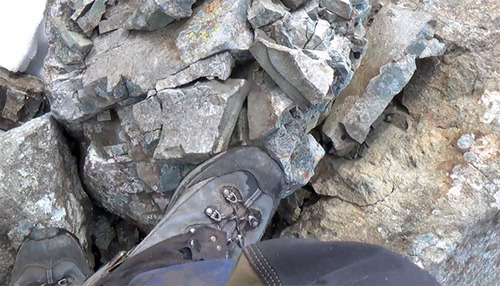
The whole scene before me screamed 'precarious’. Do people really RUN along this jumble of shifting rock? Well yes they do. Last year Finlay Wild ran the 11km from Gars-bheinn in the south to Sgurr nan Gillean in the north in a mindblowing 2 hours, 59 minutes and 22 seconds!! If you’re interested, Finlay’s blog Go Mountain Goats gives a wonderfully understated account of his light-footed traverse.
While some like Finlay Wild seem at one with the hills in ways I can’t imagine, I can’t help recall the sad incident back in 2011 when a South African climber was killed and half a dozen more were injured when they were hit by a rockfall in nearby Coire Lagan.
You need only look at the Cuillin’s giant scree slopes to get a sense of how prone to erosion and weathering the hills are, how prone to unexpected movements they are:

Indeed, once I’d negotiated my way down the scree-run back towards Glen Brittle and I was sat on a rock having my lunch in the calm, sunny and sheltered coire, I just sat and listened. Every few minutes I could hear rockfall high up on the adjacent ridge. This, perhaps more than any other landscape I’ve visited in Scotland, is one constantly on the move.
I make no apology for the fact that this account and my approach to these hills might seem overly melodramatic and fearful but, like I say, these are mountains of the mind more than any other I know in Scotland.

Climbers probably aren’t struck by that same level of fear, and though I’ve dabbled over the years I’m certainly not a climber by any stretch of the imagination. I much prefer my terra firma to be closer to the horizontal than the vertical, and in that context there’s not much I’ll shy away from on the mainland.
I love scrambling along narrow ridges and up rocky pinnacles, and a bit of exposure is great for getting the heart racing, but there’s no denying I’ve lost a bit of the devil-may-care attitude over the years. Had I ventured onto the ridge in 2004 perhaps I’d have naively trotted along the fractured rock blissfully unaware of the true dangers. I’ll never know.

All I do know is that in these later years, now that I’ve actually been up there and seen it for myself, the Black Cuillin still scare the bejeezus out of me! Despite having now made a couple of forays into these hills, unlike the Cairngorms their formidable presence in my head remains unchanged. In fact, if anything I think that they seem slightly more daunting to me now than they did before.
That’s not quite what I had hoped would happen. Perhaps it will just take more visits before they soften in appearance, or perhaps they’ll stay like this forever. Either way I’m okay with it, because I actually find it comforting that there are hills in Scotland which, even under benign conditions, inspire fear and hesitation in me. They’re a challenge, and I look forward to facing them again some time in the near future…..probably in the company of other people ;-)

I’ve since made a video blog of my first foray onto the Cuillin Ridge….
Posted on Friday, April 4th 2014
Tags Scotland Skye Isle of Skye Black Cuillin hiking hillwalking Cuillin Ridge hills mountains

Recent comments